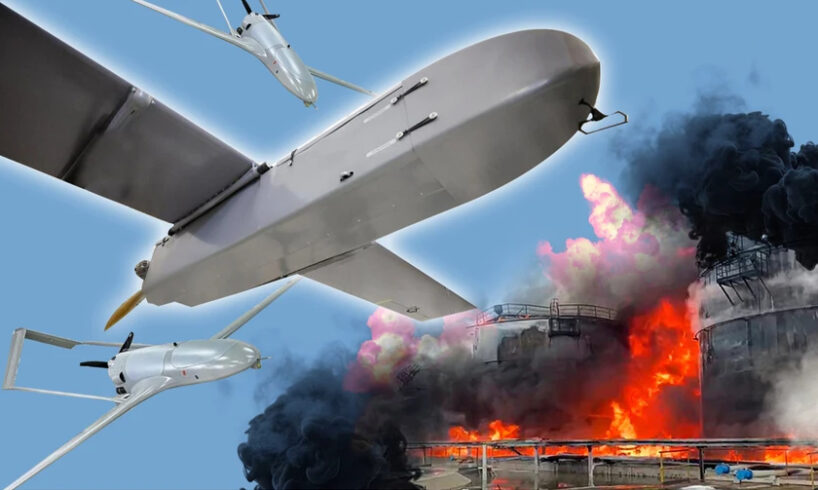
All last spring and summer, Ukraine barely touched Russia’s energy infrastructure – perhaps because of Trump’s attempt to end the war, or because of the semi-mythical “energy truce”. The focus of Ukraine’s strikes shifted to defence factories.
Between 20 March and 30 June 2025, using open sources and satellite imagery, the OSINT community CyberBoroshno recorded 19 confirmed hits on defence plants, five on military facilities, and none on energy infrastructure.
But the impact of the strikes on military plants was fairly limited. Occasionally Ukrainian long-range weapons managed to hit weapons production, but without a large number of munitions with large warheads, it was impossible to inflict decisive damage on the Russian military-industrial complex.
Advertisement:
For a long time Ukraine showed restraint and stuck to what had been agreed, refraining from striking energy infrastructure. However, after relentless Russian attacks on Ukraine’s power facilities in which Ukrainian civilians lost their lives, unilateral restraint no longer made sense, and drone operators began to strike Russian oil refineries and pipelines again.
President Volodymyr Zelenskyy has said that Ukraine is now capable of launching 100-150 drones on Russia per day. That’s several times fewer than the Russians launch, but it is having a tangible effect that can be seen in the news almost every day.
CyberBoroshno has analysed the latest strikes on Russian energy infrastructure especially for Oboronka, Ukrainska Pravda’s defence industry-related media outlet.
Advertisement:
What are Ukrainian drones hitting?
First, some numbers. CyberBoroshno only analyses strikes that have been confirmed by footage from the scene or satellite images. In total about 50 strikes have been reported, but some of these were excluded from the analysis because they have had no confirmation beyond mentions in the media.
In August and September 2025, CyberBoroshno was able to confirm 30 attacks on energy facilities on Russian territory. Of these, 23 were successful, 2 unsuccessful and 5 inconclusive.
In other words, Ukraine’s defence forces were carrying out three confirmed successful strikes a week. By comparison, from January to March 2025, another period when Ukraine was targeting Russian oil facilities, there were 2.1 successful strikes on energy infrastructure per week.
So not only has Ukraine not lost pace in its strikes on the Russian energy sector, it has actually increased it compared with the previous campaign, at least for the time being.
This isn’t just because of the success rate of the strikes, but also the fact that they were concentrated within a specific time period and focused on energy infrastructure rather than on warehouses, logistics and defence plants.
All the confirmed hits, successful and unsuccessful, are shown in the table below.
Advertisement:
The strikes on Russia’s oil refining infrastructure follow a clear and consistent logic. Importantly, many of the strikes now target essential equipment, rather than oil tanks as in the previous campaign.
It also appears that the predominant Ukrainian strike weapon, judging by the videos posted at least, is now the FP-1 drone from Firepoint. The legendary Liutyi UAVs still fly, but they are seen less often.
The FP-1 drone from Firepoint.
The largest number of confirmed successful strikes (nine) were on atmospheric and vacuum distillation units. These are the basic units of crude oil treatment, and any damage to them effectively paralyses the oil refinery, reducing the production of petroleum products or even bringing it to a complete halt.
The second-largest number of successful attacks (five) were on technological pipe racks. Four of these were recorded at refineries and one at a pumping station. Pipe racks are extremely vulnerable points of internal communications, since they carry oil and petroleum products between units. Any damage to them will prevent other sections from working, even ones that were not destroyed themselves.
In third place (four attacks) are gas fractionation units and gas and condensate processing facilities. Their role is strategic, since they produce liquefied gas and petrochemicals that are vitally important not only for domestic consumption but also for exports. Strikes on these units directly reduce Russia’s ability to supply liquefied petroleum gas to the market and to maintain a stable output of petrochemicals.
Apart from refinery strikes, there have also been hits on oil pipeline control stations and pumping stations (five confirmed hits). These are key components of trunk oil pipelines, and damage to them can halt supplies of crude for hundreds of miles, creating serious problems for both domestic logistics and export flows.
However, as noted above, not all attacks are successful. For a sober assessment of their effectiveness, a qualitative After Action Review – an analysis of the outcome of each strike – must be carried out. A spectacular photo in the news does not necessarily mean that the damage caused has hurt the Russians.
Advertisement:
Take the Ukhta Refinery, for instance. The media reported: “Explosions and air-raid warnings have been heard in the town of Ukhta. Early reports indicate that the Ukhta Refinery has been struck. Local channels are reporting a hole in an oil tank and a fire following a drone attack.”
But no confirmation of a blaze or critical damage actually followed. All the media published was a photo of a puncture in a tank that did not catch fire.
Another example: there were reports of a strike on the Saratov Refinery and even footage of an explosion. But it later transpired that the drone had landed in a nearby lake.
Photo of the strike during an attack on the Saratov Refinery.
Photo: Dnipro OSINT
Photo of the actual location of the damage caused during the attack on the Saratov Refinery.
Photo: Dnipro OSINT
Even successful operations don’t always deliver a result. For example, damage to Druzhba pipeline infrastructure only halted supplies of Russian fuel to Hungary for a few days before Russia found a way to get things going again.
Attacks have to be viewed not only in terms of flight distance or the fact that a target was hit, but first and foremost in terms of the duration of the halt in production or supply disruptions and the real impact on the system. The mere fact that the drones “flew 1,700 km” cannot in itself be considered a success.
The game continues
Many hits have proved effective and have disrupted production and logistics, but it’s still too early to draw conclusions.
To turn these isolated successes into a steady strategic outcome, a systematic approach is required: consistent verification of every case and, in parallel, improvements in the capacity, accuracy and sustainability of strikes. Equally importantly, actions must be coordinated with diplomatic and economic steps in order to maximise pressure on the Russians.
What can be said at this moment in time? Fuel shortages on the consumer market have become a problem across Russia. CyberBoroshno analysed Russian open sources and documented reports of fuel supply problems in 33 of Russia’s 83 constituent entities. We have marked them on a map.
Regions of Russia where fuel supply disruptions have been recorded.
As Ekonomichna Pravda has explained, Ukraine’s strikes on refineries are occurring during the season of peak fuel consumption. Clearly the defence forces chose just the right time to conduct the campaign.
But it would be naive to think that the fuel situation will have any effect on the availability of diesel for Russian troops. Russian tanks will obviously be prioritised for refuelling, and the shortages will mostly affect civilians and exporters.
Advertisement:
Nevertheless, this is a useful tool for keeping up economic pressure given that oil and petroleum products account for about 30% of Russia’s budget revenues – money they use to buy weapons and pay for their army of mercenaries.
It will take some time to precisely calculate the percentage of oil refining capacity that was or has been put out of operation. And statistics can be deceptive here: at the start of 2024 there were media reports that Ukraine had “instantly” knocked out 14% of Russian refining capacity.
But by the end of 2024 it was clear that Russia had repaired some plants and increased processing at facilities that had not been attacked, so that refining fell by 3% in annual terms. That’s also a result, but a far more modest one.
Now that the latest campaign is underway, different media outlets are offering different figures and conflicting opinions. For example, the Russian outlet RBC said 38% of refinery capacity has been put out of service and two-thirds of that was due to Ukrainian strikes. Kommersant, another Russian media outlet, reported a 20% fuel deficit and a million-tonne drop in production in September.
How far can the Russian media be trusted here? And if these reports are true, how long will the impact last? All will become clear later on, when it will be possible to compare income figures and establish a clear cause-and-effect link to the strikes on energy infrastructure.
For now, the Ukrainian campaign continues, and it’s too soon to draw final conclusions.
Author: Vadym Hlushko
Translation: Myroslava Zavadska
Editing: Teresa Pearce





